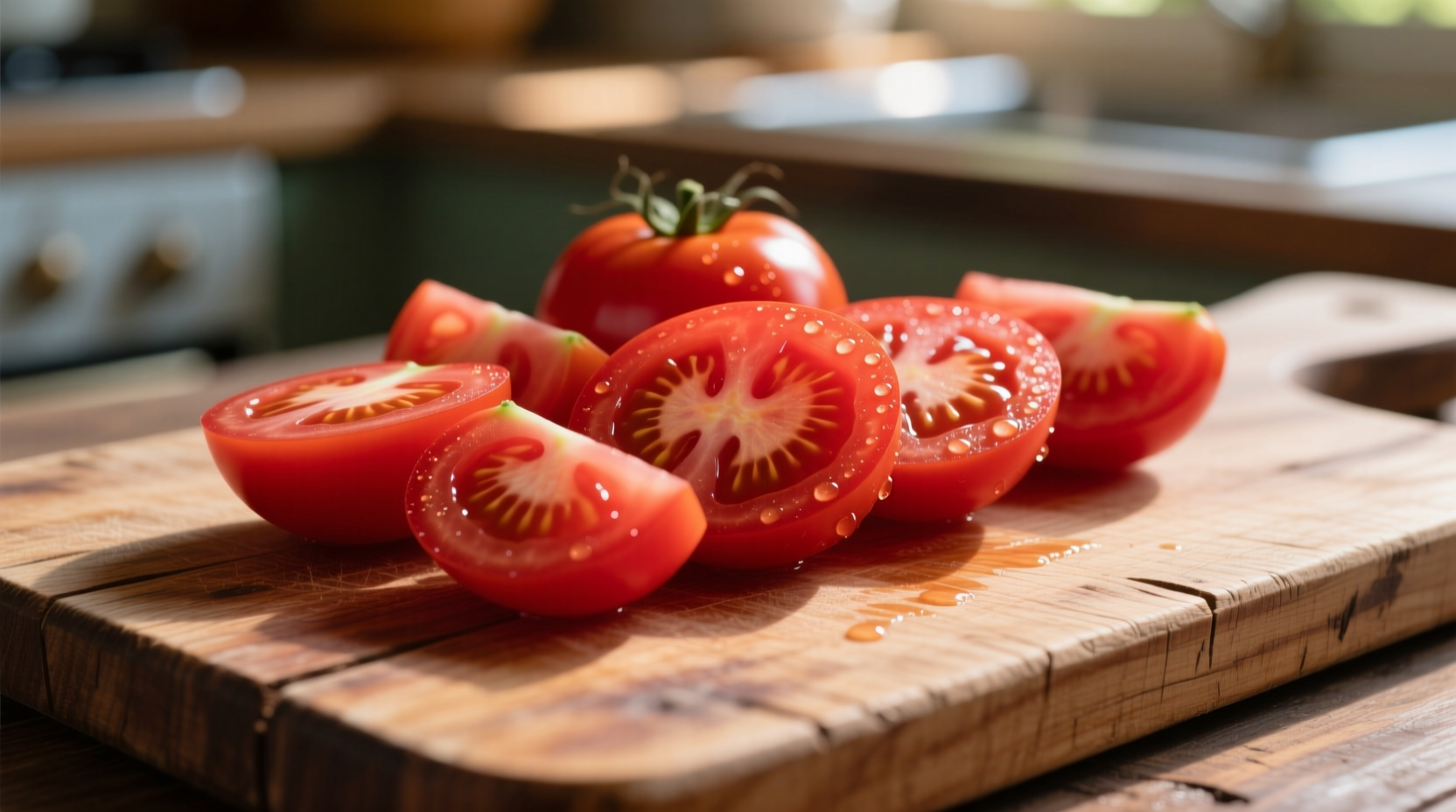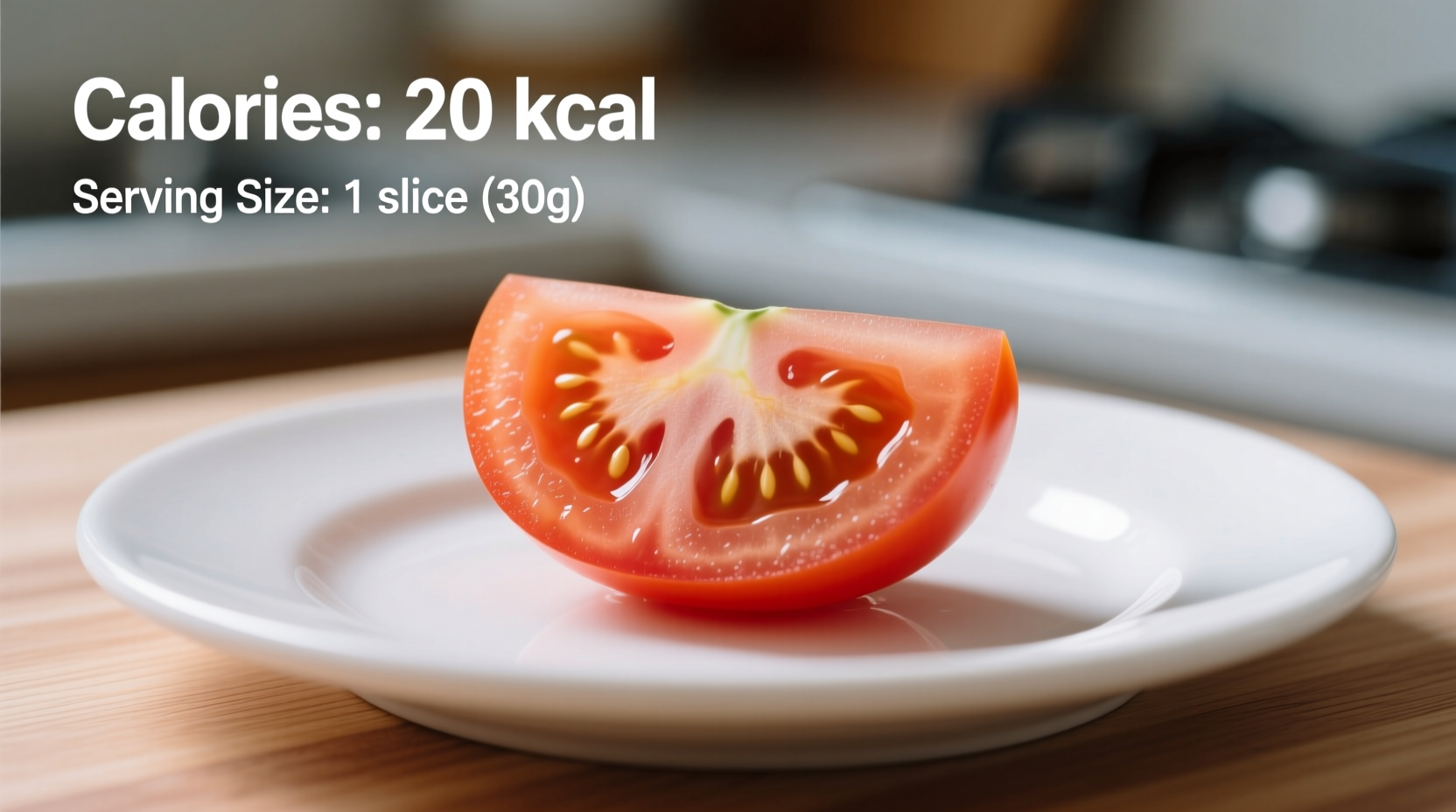Tracking calories doesn't have to mean sacrificing flavor or satisfaction. When you're monitoring your intake, understanding the precise nutritional value of individual food components becomes essential. This guide delivers accurate, science-backed information about tomato slice calories that you can trust for your dietary planning.
Understanding Tomato Slice Calorie Content
Tomatoes rank among the most nutritionally efficient foods you can include in your diet. Their remarkably low calorie density comes from being composed of approximately 95% water. The exact calorie count in a tomato slice depends primarily on thickness and tomato variety.
| Tomato Slice Measurement | Calories | Carbohydrates | Key Nutrients |
|---|---|---|---|
| 1 medium slice (1/8 inch thick, ~15g) | 1-2 | 0.4g | Vitamin C, Lycopene |
| 1 thick slice (1/4 inch thick, ~30g) | 3-4 | 0.8g | Vitamin A, Potassium |
| 1 cup diced tomatoes (180g) | 32 | 7g | Fiber, Vitamin K |
This nutritional data comes directly from the USDA FoodData Central database, the gold standard for nutritional information in the United States. The values reflect raw, fresh tomatoes without added ingredients.
How Slice Thickness Affects Calorie Count
Unlike packaged foods with standardized portions, fresh produce requires understanding how preparation impacts nutritional content. When slicing tomatoes:
- Thinner slices (1/8 inch) contain approximately 1-2 calories each
- Standard sandwich slices (1/4 inch) contain 3-4 calories
- Thick-cut slices for burgers or caprese salad contain 5-7 calories
- Cherry tomato halves contain 2-3 calories each
This context boundary matters significantly when tracking calories precisely. A single medium tomato (about 123g) contains approximately 22 calories total. When sliced into 8 equal portions, each slice contains roughly 2.75 calories.

Tomatoes in Practical Meal Planning
The exceptional nutritional profile of tomatoes makes them ideal for various dietary approaches:
Weight Management Applications
Adding tomato slices to sandwiches, burgers, or wraps increases volume and satisfaction with minimal calorie impact. A study published in the Journal of Nutrition and Metabolism found that participants who included high-water-content vegetables like tomatoes in meals reported greater satiety while consuming fewer calories overall.
Nutritional Benefits Beyond Calories
While tracking calories matters for many people, tomatoes offer substantial nutritional value beyond their low energy density:
- Lycopene: A powerful antioxidant associated with reduced risk of heart disease
- Vitamin C: Essential for immune function and skin health
- Potassium: Important for blood pressure regulation
- Fiber: Supports digestive health and satiety
Comparing Tomato Calories to Common Alternatives
Understanding how tomatoes compare to other common food additions helps make informed choices:
| Food Item | Calories per Serving | Nutritional Advantage |
|---|---|---|
| Tomato slice (1/8 inch) | 1-2 | High in lycopene and vitamin C |
| Cucumber slice | 1 | Hydrating with minimal nutrients |
| Avocado slice | 30-40 | Healthy fats but significantly higher calories |
| Cheese slice | 80-100 | Protein and calcium but much higher calorie density |
This comparison shows why tomatoes represent an optimal choice when seeking flavor and nutrition without significant calorie impact. The Harvard T.H. Chan School of Public Health specifically recommends incorporating high-volume, low-calorie foods like tomatoes for sustainable weight management.
Practical Tips for Calorie-Conscious Tomato Consumption
Maximize the benefits of tomatoes while maintaining precise calorie tracking:
- Use a kitchen scale for precise measurement when tracking strictly
- Remember that preparation method affects total calories (adding oil or dressing increases count)
- Fresh tomatoes contain fewer calories than sun-dried or canned varieties
- Cherry tomatoes provide convenient portion control (2-3 calories per half)
- When dining out, request tomato slices on the side to control portions
Common Misconceptions About Tomato Calories
Several myths persist about tomato nutrition that can lead to inaccurate tracking:
- Myth: All tomato products have the same calorie count as fresh tomatoes
Fact: Tomato sauce, paste, and sun-dried tomatoes are concentrated forms with significantly higher calories per volume - Myth: Organic tomatoes have fewer calories than conventional
Fact: Growing method doesn't affect basic nutritional composition - Myth: Different colored tomatoes have vastly different calorie counts
Fact: While nutrient profiles vary slightly, all tomato varieties have similar calorie density











 浙公网安备
33010002000092号
浙公网安备
33010002000092号 浙B2-20120091-4
浙B2-20120091-4